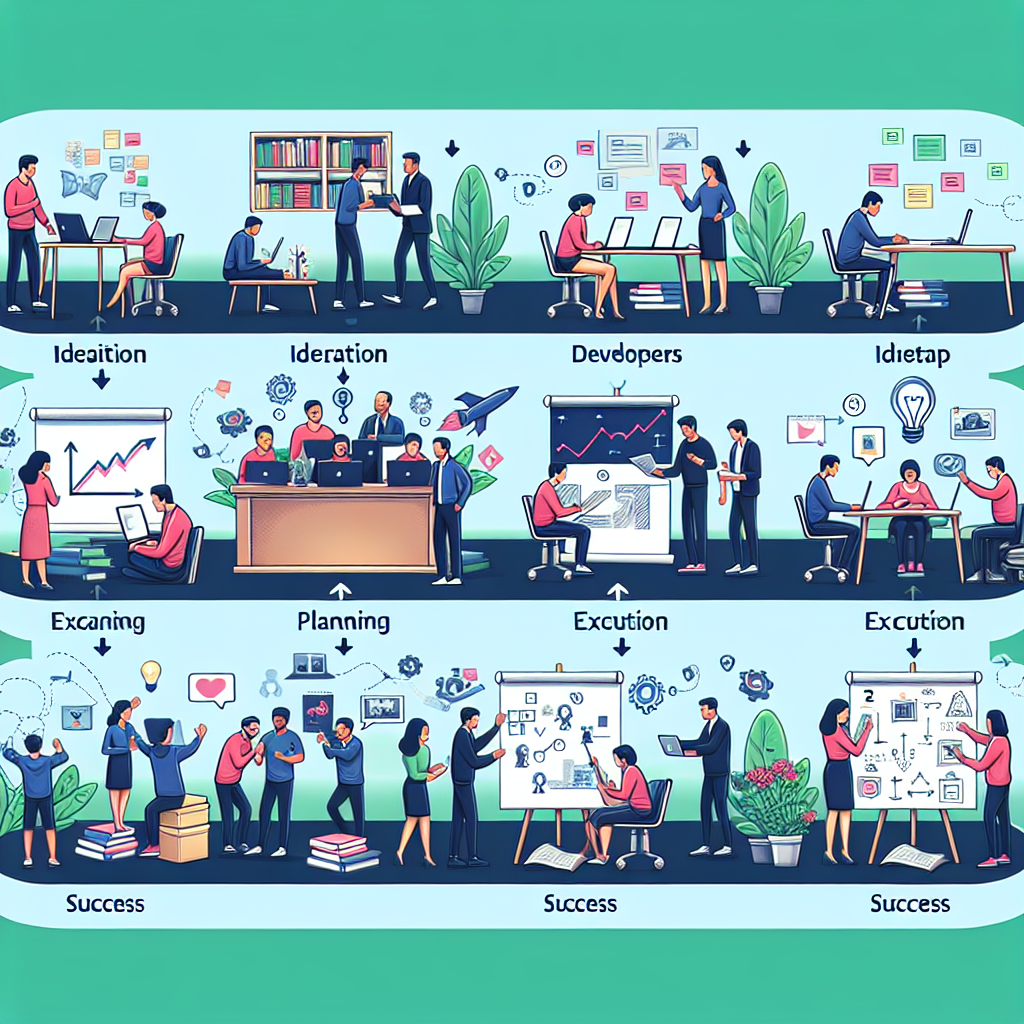5 Essential Skills Every Entrepreneur Should Master for Long-Term Success
Strategic Planning
Strategic planning is a cornerstone of entrepreneurial success, serving as the roadmap that guides a business from its inception to its long-term goals. For entrepreneurs, mastering strategic planning is not just about setting objectives but also about understanding the intricate details that can make or break a business. One of the first essential skills in strategic planning is the ability to conduct thorough market research. This involves analyzing industry trends, understanding customer needs, and identifying potential competitors. By gathering and interpreting this data, entrepreneurs can make informed decisions that align with market demands and position their business for growth.
Another critical skill is goal setting. Effective strategic planning requires setting clear, achievable goals that provide direction and motivation. These goals should be specific, measurable, attainable, relevant, and time-bound (SMART). By adhering to the SMART criteria, entrepreneurs can create a structured plan that outlines the steps needed to achieve their objectives. This not only helps in tracking progress but also in making necessary adjustments along the way.
Financial acumen is also indispensable in strategic planning. Entrepreneurs must be adept at budgeting, forecasting, and financial analysis to ensure their business remains viable. Understanding cash flow, profit margins, and investment opportunities allows entrepreneurs to allocate resources efficiently and make sound financial decisions. Moreover, having a solid financial plan can attract investors and secure funding, which is often crucial for scaling a business.
In addition to financial skills, adaptability is a key component of successful strategic planning. The business landscape is constantly evolving, and entrepreneurs must be prepared to pivot when necessary. This means being open to change, continuously monitoring the market, and being willing to revise strategies in response to new information or unforeseen challenges. Flexibility in strategic planning enables entrepreneurs to stay competitive and resilient in the face of adversity.
Communication is another vital skill that underpins effective strategic planning. Entrepreneurs must be able to articulate their vision and strategy clearly to stakeholders, including employees, investors, and customers. Good communication fosters collaboration and ensures that everyone involved understands their role in achieving the business’s goals. Additionally, transparent communication builds trust and can lead to stronger relationships with partners and clients.
Furthermore, time management is an often-overlooked but essential skill in strategic planning. Entrepreneurs must juggle multiple responsibilities and prioritize tasks to ensure that strategic initiatives are implemented efficiently. Effective time management involves setting deadlines, delegating tasks, and avoiding procrastination. By managing their time well, entrepreneurs can focus on high-impact activities that drive their business forward.
Lastly, problem-solving skills are crucial for navigating the complexities of strategic planning. Entrepreneurs will inevitably encounter obstacles and setbacks, and their ability to identify solutions quickly and effectively can determine the success of their strategic initiatives. This involves critical thinking, creativity, and a proactive approach to addressing issues before they escalate.
In conclusion, mastering strategic planning requires a combination of market research, goal setting, financial acumen, adaptability, communication, time management, and problem-solving skills. By honing these essential skills, entrepreneurs can create robust strategies that guide their business toward long-term success. The journey of entrepreneurship is fraught with challenges, but with a well-crafted strategic plan, entrepreneurs can navigate these challenges with confidence and achieve their vision.
Financial Management
Financial management is a cornerstone of entrepreneurial success, and mastering it can make the difference between a thriving business and one that struggles to stay afloat. One of the first essential skills every entrepreneur should develop is budgeting. A well-constructed budget serves as a financial roadmap, guiding you through the peaks and valleys of business operations. By meticulously planning your income and expenses, you can allocate resources more effectively, ensuring that you have enough capital to cover essential costs while also setting aside funds for future growth.
In addition to budgeting, understanding cash flow management is crucial. Cash flow is the lifeblood of any business, and maintaining a positive cash flow ensures that you can meet your financial obligations on time. This involves not only tracking the money coming in and going out but also anticipating future cash flow needs. By regularly reviewing your cash flow statements, you can identify potential shortfalls and take proactive measures to address them, such as securing a line of credit or adjusting your payment terms with suppliers.
Another vital skill is financial forecasting. This involves predicting future financial performance based on historical data and market trends. Accurate financial forecasting allows you to make informed decisions about investments, expansions, and other strategic initiatives. It also helps you set realistic financial goals and measure your progress toward achieving them. By continuously refining your forecasting techniques, you can stay ahead of potential financial challenges and seize opportunities as they arise.
Moreover, mastering the art of cost control is essential for long-term success. This means keeping a close eye on your expenses and finding ways to reduce costs without compromising the quality of your products or services. Implementing cost-saving measures, such as negotiating better terms with suppliers or adopting more efficient processes, can significantly improve your bottom line. Additionally, regularly reviewing your expenses and identifying areas where you can cut costs will help you maintain a lean and agile operation.
Lastly, developing a strong understanding of financial statements is indispensable. Financial statements, including the balance sheet, income statement, and cash flow statement, provide a comprehensive overview of your business’s financial health. By regularly reviewing these documents, you can gain valuable insights into your company’s performance, identify trends, and make data-driven decisions. Furthermore, being well-versed in financial statements will enable you to communicate more effectively with investors, lenders, and other stakeholders, fostering trust and confidence in your business.
In conclusion, mastering financial management is a multifaceted endeavor that requires a combination of budgeting, cash flow management, financial forecasting, cost control, and a deep understanding of financial statements. By honing these skills, entrepreneurs can build a solid financial foundation for their businesses, ensuring long-term success and sustainability. As you embark on your entrepreneurial journey, remember that financial management is not a one-time task but an ongoing process that demands continuous learning and adaptation. By staying vigilant and proactive, you can navigate the financial complexities of running a business and achieve your entrepreneurial goals.
Leadership and Team Building
Leadership and team building are critical components of entrepreneurial success. As an entrepreneur, mastering these skills can significantly impact your ability to grow and sustain your business over the long term. To begin with, effective communication is paramount. Clear, concise, and transparent communication helps in setting expectations, providing feedback, and fostering an environment where team members feel valued and understood. This not only enhances productivity but also builds trust within the team, which is essential for long-term success.
Transitioning from communication, another vital skill is emotional intelligence. Understanding and managing your own emotions, as well as recognizing and influencing the emotions of others, can lead to better decision-making and conflict resolution. Emotional intelligence enables you to empathize with your team, creating a supportive and motivating work environment. This, in turn, can lead to higher employee satisfaction and retention, which are crucial for maintaining a stable and committed team.
Moving forward, strategic thinking is another indispensable skill for entrepreneurs. The ability to see the big picture and plan for the future while managing day-to-day operations is a delicate balance. Strategic thinking involves setting long-term goals, identifying potential challenges, and developing actionable plans to achieve those goals. By fostering a strategic mindset within your team, you can ensure that everyone is aligned with the company’s vision and working towards common objectives.
In addition to strategic thinking, adaptability is a key trait that every entrepreneur should cultivate. The business landscape is constantly evolving, and the ability to pivot and adapt to new circumstances can make or break your venture. Being open to change and encouraging your team to embrace new ideas and approaches can lead to innovative solutions and keep your business competitive. Adaptability also involves learning from failures and setbacks, using them as opportunities for growth and improvement.
Lastly, fostering a culture of collaboration is essential for effective team building. Encouraging teamwork and creating an environment where diverse perspectives are valued can lead to more creative and effective problem-solving. Collaboration involves not only working together but also recognizing and leveraging the unique strengths and skills of each team member. By promoting a collaborative culture, you can enhance the overall performance of your team and drive your business towards long-term success.
In conclusion, mastering these five essential skills—effective communication, emotional intelligence, strategic thinking, adaptability, and collaboration—can significantly enhance your leadership and team-building capabilities. As an entrepreneur, investing time and effort into developing these skills will not only help you lead your team more effectively but also create a strong foundation for your business to thrive in the long run. By continuously honing these skills and fostering a positive and productive work environment, you can set your business on a path to sustained success.
Marketing and Sales
In the dynamic world of entrepreneurship, mastering certain skills can significantly enhance your chances of long-term success. Among these, marketing and sales stand out as crucial areas where proficiency can make or break your business. To navigate this complex landscape effectively, there are five essential skills every entrepreneur should master.
First and foremost, understanding your target audience is paramount. Knowing who your customers are, what they need, and how they behave allows you to tailor your marketing strategies to resonate with them. This involves conducting thorough market research, analyzing consumer data, and staying attuned to trends and shifts in your industry. By doing so, you can create more personalized and impactful marketing campaigns that speak directly to your audience’s desires and pain points. This not only helps in attracting new customers but also in retaining existing ones, fostering loyalty and long-term relationships.
Transitioning from understanding your audience, the next critical skill is effective communication. As an entrepreneur, you must be able to convey your message clearly and persuasively, whether it’s through advertising, social media, or face-to-face interactions. This involves not just speaking or writing well, but also listening actively to feedback and engaging in meaningful dialogues with your customers. Effective communication builds trust and credibility, which are essential for convincing potential customers to choose your product or service over competitors.
Moving forward, another indispensable skill is digital marketing proficiency. In today’s digital age, having a strong online presence is non-negotiable. This encompasses a wide range of activities, from search engine optimization (SEO) and content marketing to social media management and email campaigns. Mastering these tools and techniques allows you to reach a broader audience, track your marketing efforts’ effectiveness, and adjust your strategies in real-time. Moreover, digital marketing offers cost-effective ways to promote your business, making it accessible even for startups with limited budgets.
In addition to digital marketing, sales acumen is a vital skill that every entrepreneur should develop. This goes beyond merely closing deals; it involves understanding the sales process, building relationships, and providing exceptional customer service. A good salesperson knows how to identify potential leads, nurture them through the sales funnel, and convert them into loyal customers. This requires a combination of empathy, persistence, and strategic thinking. By honing your sales skills, you can drive revenue growth and ensure the sustainability of your business.
Lastly, adaptability is a crucial skill that ties all the others together. The business landscape is constantly evolving, and what works today might not work tomorrow. Being adaptable means staying open to new ideas, continuously learning, and being willing to pivot your strategies when necessary. This could involve experimenting with new marketing channels, adopting innovative sales techniques, or even rebranding your business to stay relevant. Adaptability ensures that you can respond to changes swiftly and effectively, turning potential challenges into opportunities for growth.
In conclusion, mastering these five essential skills—understanding your target audience, effective communication, digital marketing proficiency, sales acumen, and adaptability—can significantly enhance your marketing and sales efforts, paving the way for long-term success. By investing time and effort into developing these skills, you not only improve your chances of thriving in a competitive market but also build a solid foundation for your entrepreneurial journey.
Adaptability and Problem-Solving
In the ever-evolving landscape of entrepreneurship, adaptability and problem-solving stand out as two of the most crucial skills for long-term success. As markets shift, technologies advance, and consumer preferences change, the ability to pivot and address challenges head-on becomes indispensable. Entrepreneurs who master these skills not only survive but thrive in the face of uncertainty.
To begin with, adaptability is the cornerstone of entrepreneurial resilience. In a world where change is the only constant, being adaptable means staying open to new ideas, embracing innovation, and being willing to alter course when necessary. For instance, consider how many businesses had to rapidly transition to online models during the COVID-19 pandemic. Those who could quickly adapt to the new normal were able to maintain operations and even find new opportunities for growth. This flexibility is not just about reacting to external changes but also about proactively seeking ways to improve and stay ahead of the curve.
Moreover, adaptability is closely linked to a growth mindset. Entrepreneurs with a growth mindset view challenges as opportunities to learn and grow rather than as insurmountable obstacles. This perspective fosters a culture of continuous improvement and encourages teams to experiment, take calculated risks, and learn from failures. By cultivating a growth mindset, entrepreneurs can better navigate the complexities of running a business and inspire their teams to do the same.
Transitioning to problem-solving, this skill is equally vital for entrepreneurial success. Every business, regardless of its size or industry, encounters problems. Whether it’s a supply chain disruption, a sudden drop in sales, or a conflict within the team, effective problem-solving can make the difference between a minor setback and a major crisis. Entrepreneurs who excel in problem-solving approach issues methodically. They gather relevant information, analyze the situation, brainstorm potential solutions, and implement the most viable option. This structured approach not only helps in resolving the immediate issue but also in preventing similar problems in the future.
Furthermore, problem-solving often requires creativity and out-of-the-box thinking. Traditional solutions may not always work, especially in unprecedented situations. Entrepreneurs who can think creatively are better equipped to devise innovative solutions that can give their business a competitive edge. For example, when faced with a saturated market, a creative entrepreneur might identify a niche segment that is underserved and tailor their offerings to meet that specific demand.
In addition to creativity, effective problem-solving also involves collaboration. No entrepreneur operates in a vacuum, and leveraging the collective expertise of a team can lead to more robust solutions. Encouraging open communication and fostering a collaborative environment can help uncover insights that might not be apparent to a single individual. This collaborative approach not only enhances problem-solving but also strengthens team cohesion and morale.
In conclusion, adaptability and problem-solving are essential skills that every entrepreneur should master for long-term success. By staying flexible and open to change, entrepreneurs can navigate the uncertainties of the business world with confidence. Simultaneously, by honing their problem-solving abilities, they can tackle challenges head-on and turn potential setbacks into opportunities for growth. Together, these skills form a powerful combination that can propel an entrepreneur towards sustained success in an ever-changing landscape.




















